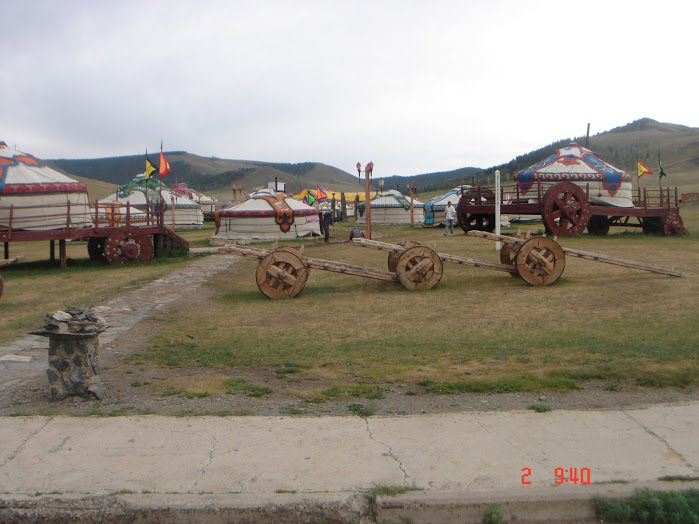In Pictures: Stunning Mongolia & the Tomb of Genghis Khan
- Dr. K.

- Apr 13, 2020
- 5 min read
Updated: May 27, 2022
Several years ago, my brother went on an expedition with Dr. Woods from University of Chicago's Graham School to find Genghis Khan's tomb in Mongolia. In our most recent chat, he relives those memories and tells me all about them!


Mongolia is definitely an untold story. So - Why Mongolia? Who did you go with? How did you get there?
A lot of my journeys start with a book. In this case it was 'In Search of Genghis Khan' by Tim Severin. Here's a glimpse of why it was so fascinating:
"For those who know him only as a character in Bill & Ted’s Excellent Adventure, the real Genghis Khan (known to the Mongols as Chinggis Khan) is the Asian-history equivalent of Napoleon or Alexander the Great. The thirteenth and fourteenth centuries were all about Genghis and his descendants, the Great Khans. At its height, the Mongol empire stretched from modern-day Korea to Poland and from Iraq to Vietnam. By the end of the 1200s, Genghis’s sons and grandsons—including Marco Polo’s pal Kubilai—had amassed the largest contiguous land empire in world history. It was more than twice the size of the Roman Empire and more than four times the size of Alexander the Great’s."
-In Search of Khan; AmericanWay Magazine, June 15, 2007

I was mesmerized by the book and it referenced works by Dr Woods from Chicago. I was living in Chicago at that time and was taking classes at the Graham School. I decided to drop an email to Dr Woods who invited me to join an expedition that he was leading to meet the archeologists doing work in Mongolia. I jumped on the opportunity.
We were about ten of us who were brought together by Dr Woods from various walks of life and from all over the US.
I flew from Chicago to Seoul and then hopped on a MIAT (Mongolian Airlines) flight to Ulaanbaater, the capital of Mongolia where I met with the group.
What was your base city? Tell me about the excursions.
We used the Bayangol Hotel in Ulaanbaatar as a central base, and made excursions of several days each from there to other parts of Mongolia.

First Excursion: Blue Lake of the Black Heart Mountain, found about 175 miles east and slightly north of Ulaanbaatar - At this spot in 1189 the 27-year old Temujin was first elected a Khan (ruler) by a khuriltai (council) of his family and neighboring Mongol tribes.

Second Excursion: Genghis Khan Expedition Site at Öglögchiin Kherem - the "Almsgivers Wall", a 3.2km-long stone wall believed to date from the 8th Century. It surrounds a rocky hillside ("Almsgivers Castle") on which more than 60 graves have been found in minimal excavations to date.
The expedition had an exclusive permit from the government of Mongolia to map, study, and excavate at this site. The main objective was to discover if the site contained the graves of Genghis Khan or other Mongolian royalty of his period. Although this was not conclusively established before the Expedition's budget ran out, there were many other noteworthy discoveries. Additional information can be found here.
Third Excursion: Further northeast of the Genghis Khan Expedition site is the village of Binder, located at the confluence of the Khurkh and Onon Rivers.

Not to be outdone by a foreign-led expedition, a Mongolian Government official subsequently had a grander marker installed nearby.

Leaving Binder, we stop at Rashaan Khad, a prominent rock bearing a great many carved inscriptions in Orkhon, Hidan, Arabic-Persian, Chinese, Tibetan and Mongolian languages.

Our overnight stop is at the Khödöö Aral Ger Camp at Delgerkhaan, fairly typical of ger camps for tourists in Mongolia. There is a central building with showers and toilets, a large central dining ger (picture above), and a number of smaller guest gers.


Second part of our trip lets us explore some of the other areas of Mongolia.
In this part of our tour we visit the Gandan Monastery in Ulaanbaatar, then depart for the Khustain National Park and its Prezewalski horses before going on to Kharkhorin.
At Kharkhorin we enjoy a concert featuring traditional instruments, throat singing and acrobatics; view the annual Naadam Festival; inspect Turkic artifacts being preserved while a new museum is constructed; and tour the Erdene-Zuu Monastery.
I am told Mongolia is very different from most places we know. Did you a feel a sense of culture shock? Is the country an amalgamation of different cultures or is there such a thing as 'Mongolian' culture? Do they have their own language, dress, customs?
"MONGOLIA SHOCKS first-time visitors, and not just because things like the local drink (a beverage traditionally made with fermented mare’s milk, called kumis) are slightly less than appetizing, but because the whole experience feels a lot like an interplanetary journey — to planet Genghis. Imagine combining George Washington with Justin Timberlake. Genghis is that ubiquitous, and that revered."
There's definitely a shock when you land in Mongolia and start talking to people about Genghis Khan.
"Mongolia is three times the size of California and has about 2.83 million people, about half of whom are concentrated in the capital, so a journey into the sparsely populated countryside can seem like a trip back in time. Many rural Mongolians still live the same way as those who lived during the time of the Khans. They learn to ride horses before they can walk; they dress in traditional deels (gowns); and they dwell as nomads, moving their circular gers (yurts) from valley to valley, just as their famous ancestor did. Genghis is omnipresent. Everyone knows the story of his life, death, and secret burial. "
There is a very strong sense of the nomadic culture that I haven't seen anywhere else.
On our way south from Binder to Delgerkhaan we visit a Mongol family at their camp, which consists of three gers, a shed, a few dogs, and a great many horses. The ger we are invited into seems to be primarily the realm of the grand papa and children. We are entertained with conversation (a bit strained in translation) and snacks, including the ubiquitous fermented mares milk. Yummy.
Can a vegetarian survive on Mongolian food?
It was quite difficult to get anything vegetarian outside of UB. I mostly survived on Rice and Goat Milk. I would recommend anyone who decides to go there to take some camping food with them. Mongolian diet is primarily meat based.
What are your most special memories of Mongolia? What advice do you have for folks who want to travel to this almost untouched adventure?

The adventure of an expedition was the most exciting part. We were living in gers, traveling hundreds of miles in Russian jeeps and meeting archeologists from all over the world searching for the tomb of Khan.
There was a respect for history and an interest in discovering more of this unknown territory,
The beauty of the steppes was another thing that took me by surprise, the landscape is like no other, you want to just immerse yourself in it.

One of the things that I loved was the Nadaam Festival, people from all over Mongolia came with their horses to race them.
We saw some really fun exchanges, dances, music from all over the country. If you plan on visiting this country, look up the dates of this festival and visit during that time.
About our travel nomad, Pranjal (PJ)
"I have designed my life so that travel is front and center of it, first via IT consulting and then gradually by adopting the digital nomadic lifestyle. I got introduced to travel via a study abroad program in sophomore year of college and then after graduation I started looking for jobs that geared towards it. What motivates me as a traveler is the knowledge that every person and every place is unique and will teach me something new. Food is something that connects me to a place and the people in it. As a vegetarian, I am always trying to understand how the locals relate to nature around them.The evolution of food through history also helps in understanding the local culture and customs. To me that is the most fascinating aspect of travel."













































































